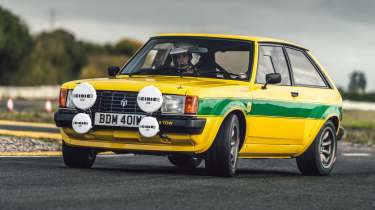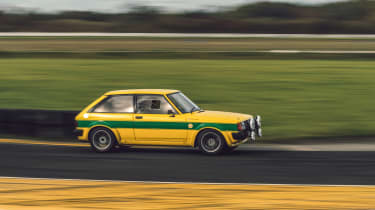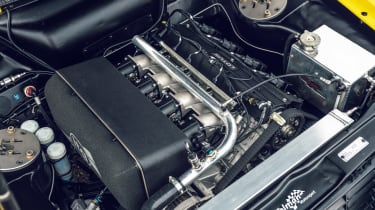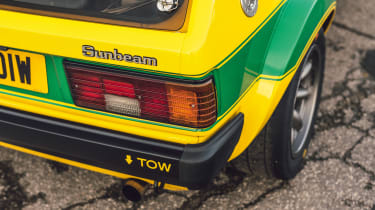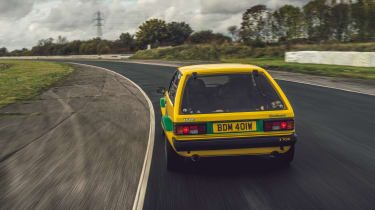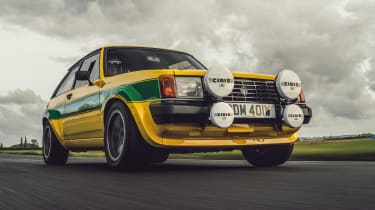Talbot Sunbeam Lotus by Tolman Engineering 2022 review
The Talbot Sunbeam Lotus is an early-’80s classic; reimagined by Tolman Engineering with 21st century hardware and electronics, it’s also an absolute joy
Certain cars I’ll always associate with particular individuals. Ferrari F40? That VHS I had as a kid in which a flat-capped, moustachioed Mansell melted Pirellis and showed it who was boss at a misty Fiorano. Ford Sierra RS500 Cosworth? Andy Rouse, intense in an open-face helmet, beating the Texaco works car at Brands Hatch while I jumped up and down in front of the telly. Original Group A Prodrive Subaru Impreza? Col… You get the idea.
When it comes to the Talbot Sunbeam, that rather unlikely hot hatch that transformed into a rallying world-beater via Lotus and the Coventry-based Talbot competitions department, it’ll always be the young Henri Toivonen, the superstar sensation of 1980s rallying.
> Pug1Off Peugeot 205 GTI 195 review
Toivonen ran a limited programme in 1980 but took a surprise win on the Lombard RAC at the end of that year; his efforts in 1981 brought him seventh overall in the drivers’ standings and contributed to Talbot winning the manufacturers’ crown. Even though I was too young at the time to watch it first hand, if I close my eyes I can picture him totally sideways past perilous forest log-piles, miles over the limit, setting fastest stage times or spearing off into the undergrowth for another car-wrecking shunt put down to youthful exuberance. And all with that cheery, cheeky persona that would rapidly make him a hero to millions.
More reviews
Group tests
- Alpine A290 v Alpine A110 – how much DNA do they really share?
- Ariel Atom 4R v Caterham Seven ‘evo25’: power-to-weight heroes go head-to-head
- Caterham Super Seven 600 v Super Seven 2000
- Levante v T1
- Corvette Stingray v Porsche Cayman GTS v Audi R8 RWD
- Great Ferrari hypercars driven: 288 GTO, F40, F50 and Enzo head-to-head
- Hardcore Ferrari V8 specials go head-to-head
- Lamborghini Aventador Ultimae v Lamborghini Countach
- Lotus Emira v Morgan Plus Four – four-cylinder Brits go head-to-head
- Toyota GR86 v BBR Mazda MX-5: supercharged drop-top battles sports coupe
In-depth reviews
- Abarth 600e 2025 review – Italy gives the Alpine A290 something to worry about
- Alpine A110 review – distinctive, lightweight and unforgettable to drive
- Audi R8 (2015 - 2024) review – the ultimate soft-focus supercar
- Bentley Continental R Mulliner: review, history and specs
- BMW 5-series review – is this still Munich’s anchor model?
- BMW 1-series review – Munich’s Audi A3 rival gains focus
Long term tests
- Abarth 695C Turismo Fast Fleet test – 10,000 miles in the Italian hot hatch
- Alfa Romeo Giulia Veloce Fast Fleet test – 7000 miles in the sharp Italian saloon
- Alpina B10: end of term report
- Alpina B10
- Ford Mustang GT
- Ford Mustang GT
- Ford Mustang GT
- Land Rover Defender 110 Fast Fleet test – 9000 miles in the go-anywhere SUV
- Maserati Ghibli Trofeo Fast Fleet test – 4000 miles in the Ferrari-powered saloon
- Mitsubishi Evo MR 340
Review
- New Aston Martin DBS 770 Ultimate review – 759bhp super-GT driven
- New Bentley Batur 2023 review – can it possibly be worth £1.65m?
- 2023 Chevrolet Corvette C8 Z06 review – the American 911 GT3?
- Kia EV6 GT-Line S prototype review – the EV that shows how it’s done
- BBR Supercharged Mazda MX-5 (ND) 2023 review – tuned 250bhp roadster driven
- MG4 Trophy 2023 review
Reviews
- Abarth 695 75 Anniversario edition 2024 review – a fitting send-off for Abarth’s hot supermini?
- Abarth 500e 2023 review
- AC Cobra 378 Superblower MkIV 2021 review – another V8 Cobra, but with a GM heart this time
- Acura Integra Type S 2024 review – a Honda Civic Type R with added restraint
- Alfa Romeo Giulia 2025 review – get one while you still can
- Alfa Romeo SZ: history, review and specs of an icon
- Alfa Romeo 1750 TBi
- Alpina B3 GT Touring 2025 review – a 190mph alternative to the BMW M3 Touring
Now I’m sitting in something akin to a Group 2 Talbot Sunbeam Lotus, looking out of a Perspex side window from within my open-face helmet while a mechanic makes some final checks, and I’d be lying if I said I was able to suppress a grin as the stored imagery and anticipation of driving this car take a hold.
If the Talbot Sunbeam Lotus is before your time, then consider it as a forebear to everything we now consider a hot hatch. Like the Mk1 and Mk2 Ford Escorts, it was rear-wheel drive, as even small cars tended to be back then, but unlike most of them it had a hatchback not a saloon body, something it shared with the rival Vauxhall Chevette HS. This duo of hairy chested rear-drive hatches formed the last of the old guard before the influence of the Mk1 Golf GTI changed the market forever.
What made the Sunbeam special was the use of the potent 2.2-litre Lotus four-cylinder twin-cam engine. Some 150bhp in road trim made it a rapid car for its time, but in Group 2 rallying spec that figure rose to well over 200bhp, allowing the tough, nimble little car to challenge for outright rally wins, even against theoretically more specialised Group 4 opposition such as Lancia’s Stratos.
This car is the work of Tolman Engineering, based in the British Midlands. The company’s eponymous director, Chris Tolman, has a link to the Sunbeam legend that goes right back to the beginning, and then comes full circle more than once. ‘My father worked for a Rootes [Group] Talbot dealer in Dorset during 1981, and I can remember seeing a replica of the works [rally] car at a steam fair; I had stickers of it on my bedroom door,’ he recalls.
‘Dad then moved to a Lada and Mazda dealership and began rallying a Lada, and it was then that I said, “That’s what I want to do.” At 14 I bought a Talbot Sunbeam and was storing parts for it under my bed. I built it into a works replica on a tiny budget, even if it only had a 1300cc engine. Dad’s boss at the time had been apprenticed to Des O’Dell.’ It was O’Dell who ran the Talbot competitions department in the UK, latterly Peugeot Sport UK.
After training as an engineer in the aircraft industry, Chris joined Prodrive and worked on its BTCC title-winning Ford Mondeo campaign before, at the age of 24, joining Ralliart – the close-knit, Midlands-based works squad that ran Tommi Mäkinen et al in the World Rally Championship on behalf of Mitsubishi. ‘I fulfilled my dream of becoming a rally mechanic, travelling the world: my first event was the 2000 RAC, and I did the last Safari Rally in 2002. They were the best guys, and the relationships and connections I made there have stood me in good stead.’
Among those, Ralliart boss Andrew Cowan became a friend. In his prime, Cowan had been a works driver for – you guessed it – the Rootes Group.
Soon after Chris battled with and eventually defeated a severe illness, Ralliart closed and he was forced to strike up on his own from virtually nothing. Since then he’s grown the business to encompass historic race car restoration and prep, contemporary GT racing – including becoming McLaren’s official GT driver development programme partner – and the restoration of modern classic road cars.
The yellow machine you see on these pages came about through a chance conversation with one of Tolman’s established clients who had been enjoying some track mileage in his Ferrari 458 Challenge. At the end of the test, Chris happened to make ‘a flippant comment’ about Sunbeam Lotuses, and the aforementioned client remarked that he’d been searching for two years for the right car but hadn’t found it. Pretty soon Chris had started building him one…
In fact, he would build two: a road car, and this, a trackday car that, eventually, would also be made road-legal. ‘I know Sunbeam parts are rare, so we were never going to destroy anything original,’ explains Chris. ‘Instead, I decided we’d build a Group 2 bodyshell without any extra welding or cutting of holes, thereby preserving the value in the car, and then fit it out with the best modern technology we could incorporate.’
Much of what followed was started from a clean sheet of paper, and when Chris calls it a GT3-spec Sunbeam Lotus you soon get the idea that it’s a little bit special. The 2.2-litre engine has been built to full works spec by Phil Davidson, who had been an apprentice at the Talbot competitions department to the same man that Chris’s dad had latterly worked for, and who had built the works rally engines in period, and later the engines for the Ralliart recce cars too (another circle thereby completed).
With throaty carbs and a distributor, the twin-cam made 242bhp on the dyno, but Chris then removed the old tech and fitted a complete MoTeC M150 management system with fly-by-wire throttle bodies, eight injectors, coil-on-plug ignition and Tolman’s own cam sensor set-up to make an engine that produces 265bhp and revs to nearly 8000rpm. The complete spec includes a power distribution module, a CAN bus bespoke wiring loom, and traction and launch control. The electronics also play their part in controlling the Drenth six-speed sequential gearbox and Geartronics pneumatic paddleshift system, and there’s a digital dash display with a graphical reproduction of the Sunbeam’s original dial pack.
The caged shell is built to modern standards (FIA Historic spec) with TIG welding but in a period style, though there’s a new front subframe to enable an adjustment to the roll centre. The wings are steel but the arches aluminium, as they were in period, as also was the aluminium bonnet, but elsewhere Chris has indulged the owner’s ‘carbonfibre fetish’ with a carbon dash, door cards and Corbeau seats. Tolman worked closely with Nitron suspension and the result is three-way adjustable dampers with remote reservoirs and adjustable top mounts, set up with plenty of compliance to bring as much grip as possible. At the rear there’s a Salisbury limited-slip diff.
I could go on, talking about the lithium-ion battery, the adjustable AP pedal box, ATL fuel cell and AP four-pot brakes with rear axle disc conversion, but I think you get the idea. This may look very much like a Talbot Sunbeam Lotus, but underneath the immaculately restored and perfectly painted skin it’s very much 21st century.
Once I’m in, harnessed tightly in place, my hands are at the perfect stretch for the Alcantara-clad wheel. All around it looks like a modern, professional motorsport machine; it feels like one, too, and even smells like one: that pungent but somehow weirdly alluring scent of fresh fuel, solvent cleaning fluid, polish, rubber and hot oil. Everything is beautifully finished, and as the ‘four’ kicks into life I can feel the excitement build in my stomach.
Blyton Park in mid-winter is not perhaps the most welcoming of places, but the track’s slick, frosty top layer promises negligible grip levels and enticingly effortless ways to exceed the limit of grip. You need the clutch only to move away from rest, after that you can forget it, and there’s no drama to the process as long as you’re sensitive with your feet and smooth. Once up and running, it’s just a case of pulling back on the paddle and grabbing another gear, and then another gear after that, each one meshing instantly with the sort of positive thud you only tend to get with pneumatically powered systems. There’s a central shift lever, too, at the client’s request, which moves even if you decide to use the paddles.
As I turn into the pitlane it’s obvious that there’s some serious weight to the Talbot’s steering (a power steering set-up is a work in progress), but the electronically finessed four-pot is far better mannered than the angry thrashing sound blasting through the bulkhead would have you believe. It pulls from low revs without complaint, despite the obvious impending burst of energy to come at higher revolutions, and is clearly going to make short work of the car’s miserly 958kg kerb weight.
Fully uncorked, the Sunbeam is as bright-eyed as you’d imagine, zapping up to 7000rpm (peak power is at 7500rpm, but the shift lights are set to 7200rpm today) and delivering frantic bursts of short-geared acceleration. The AP brakes are a fine partner, with just the sort of reassuringly meaty pedal response that you might imagine; in fact the whole car has a definite heft to how it needs to be driven, but without ever feeling stodgy. You have to be deliberate with it, but there’s still delicacy and vivid clarity to its responses.
We hurtle into Blyton’s tightening first turn that funnels into the chicane. Press too hard on the middle pedal and you can sense the fronts on the verge of locking up; turn in too briskly and the fat Pirelli P7 Corsas, shod on plump little 15-inch alloys, start to nibble away on the edge of understeer, the steering lightening in a clear message that this morning’s meagre peak grip level is already nearly exceeded. With the Pirellis still cold, I’m not that surprised, but the answer is to drive faster to get some heat in them – or use the brakes more on the way in to get the car turned.
I try the latter as much as I can, because particularly on a short, tight circuit such as this one the temptation is to try to drive the Sunbeam like a rally car as much as possible. Be damned with smooth lines and ultimate speed, I want to feel it sliding – and, once achieved, it’s addictive. As Chris promised, the Nitrons are set surprisingly soft, but rather than make the Sunbeam feel wallowy they give it an amazing amount of traction even in these conditions.
Driving out of a turn, you can really sense the car sitting back on its outer rear wheel, the tyre being squished into the road’s surface and the car punching forward from there. That is, until you can overwhelm it, and then you get the most natural slide, the once-heavy steering feeling entirely natural, its accuracy – and the deliciously sharp and linear throttle – making it all so easy. It’s so good, I don’t want the session to end. Do they offer in-flight refuelling? Is there an extendable boom that plunges into a basket?
There isn’t, of course. I get another go on a – slightly – drier track and some of the tendency towards drifting is replaced by sheer speed. The Sunbeam positively whips around the little track – it really is a rapid little thing, no doubt easily capable of embarrassing a supercar in this environment on all bar top speeds.
Still, given the inevitable cost, that attribute should be very much on the menu. At £200,000, this car breathes the same rarefied air as Cyan Racing’s awesome £450,000 P1800 (evo 282). As fabulously appealing as these fusions of classic design, driver interaction and modern technology and ability are, they’re a supercar alternative, and very much not something for the average car enthusiast. Nevertheless, Tolman is ready with some numbers to justify its asking price: there’s £25,000-worth of work in getting the body to standard, even before inserting the roll-cage – ‘They’re all rotten,’ notes Chris – and the car has a full ‘dry build’ even before it goes into the paint shop. The gearbox is £10,000, the dampers £5000 and the electronics a whopping £20,000. The pedal box alone is £10,000.
When Chris calls it a GT3 Sunbeam, he’s not joking – it uses the best of the best. So all I can really conclude with is that I can’t recall a supercar making me grin and whoop with joy as much as this car, and therefore, if I did have the means, I’d be asking Chris to build me one pronto. Mine will be painted white with a blue stripe, and I’ll call it Henri.
Talbot Sunbeam Lotus specs
| Engine | In-line 4-cyl, 2172cc |
| Power | 265bhp |
| Torque | n/a |
| Weight | 958kg |
| Power-to-weigh | 276bhp/ton |
| 0-60mph | <4.0sec (est) |
| Top speed | c130mph (est) |
| Price | £200,000 (tolmanengineering.co.uk) |
This story was first featured in issue 285.

